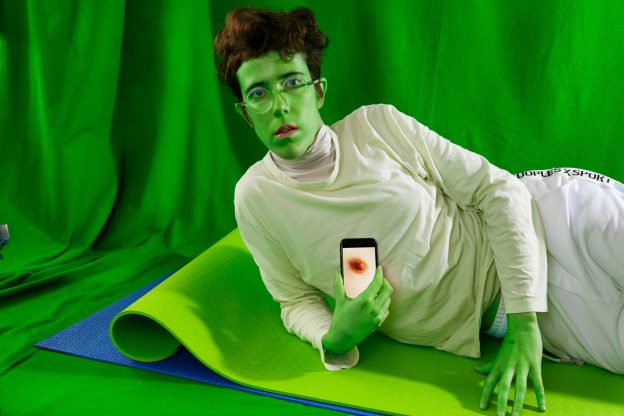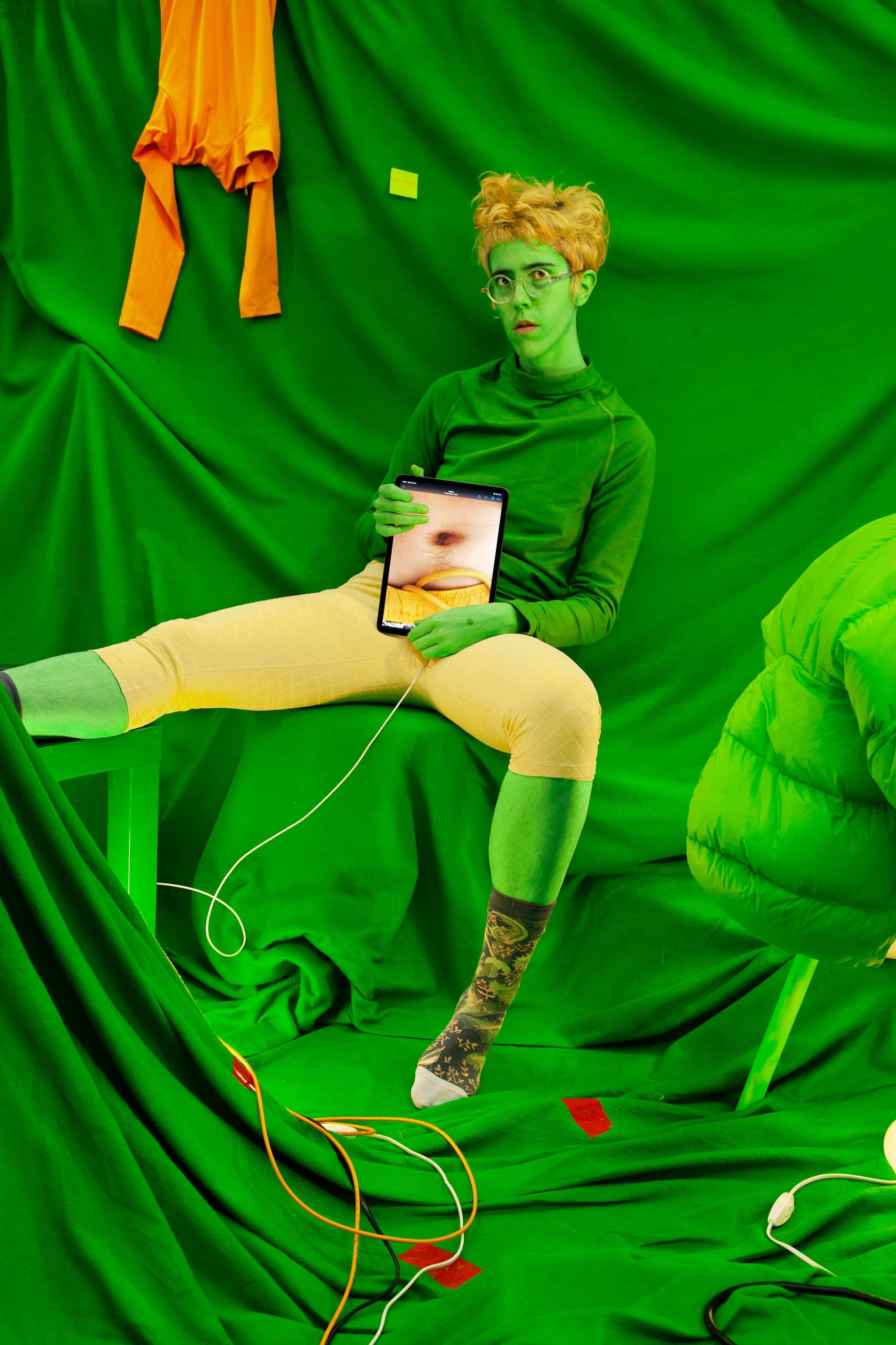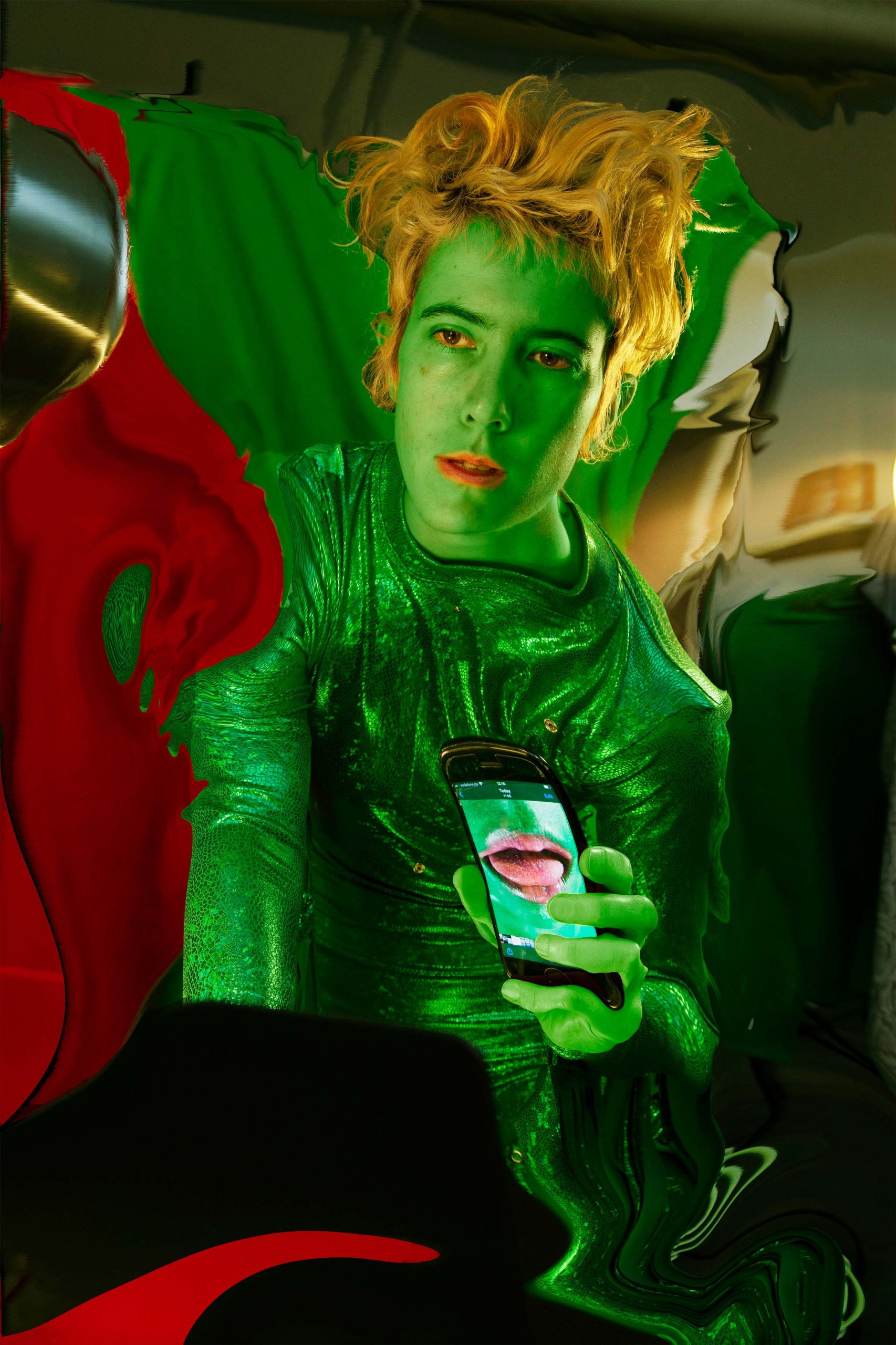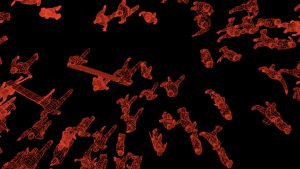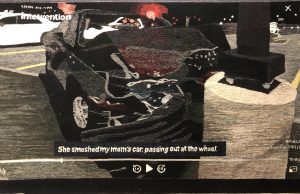with ALL OF THAT SKIN INTO MY SCREEN INTO MY HAND
artwork by JEANNE TULLEN
Abstract: In this essay the reader is guided through the difficulties and complexities of analytic work and its history, and is asked to consider the resonances between art, therapy, and selfhood in general. As Goren suggests, intimacy—though difficult for many, perhaps especially for therapists—emerges as essential to the healing potential of the analytic situation.
Imagine you happen upon a waddle of, say, 450 Adelie penguins; the small cute ones common to the Antarctic coast. These particular specimens seem to be a dwarf variety, less than a foot tall. When you approach, something strange happens; as you move, they make tiny positional shifts in sync. To your eye, their synchronized movements create black and white shape-shifting patterns that swell, throb, and undulate across the colony like the chromatosphoric displays of a dreaming octopus. Now, imagine your wonderment at realizing you are actually looking at a reflection of yourself, a moving mirror image beamed back at you in penguin plumage.
Funny isn’t it? Sadly, these are not fowl with higher powers, and neither are we on a virtual tour of a Terry Pratchett Discworld theme park. This is an installation named “Penguins Mirror,” the brainchild of American-Israeli artist, Danny Rozin. These birds are, in fact, fluffy toys operated by small motors triggered by an Xbox programmed to convert motion sensor data into movement; each penguin is a pixel in the puzzled-out portrait of your moving body.
The impact is immediate and mesmerizing, particularly given that these surfaces are obviously, if counter-intuitively, non-reflective. “The way that we perceive ourselves,” Rozin explains, “is in very stark contrast to the way that other people see us. And when you gaze into a mirror, that divide collapses.” Whether or not you agree, Rozin is clearly out to disrupt our sense of ourselves.
A troublingly disrupted sense of self is what we often bring to therapy and hope to have relieved. And, as the psychoanalytic story goes, what we are too often suffering from is the disruptive symptoms of an event, experience, or trauma, long-buried and too painful to bear thinking about. Core to the psychoanalytic project is the idea of gently holding up a mirror to reflect what might be occluded from our self-awareness, and by doing so, somehow relieve us of our burden. However, for so many reasons, this doesn’t always work.
When it comes to helping fourteen-year-old Maisy-Grey, mirroring or reflection of any kind is out. Seduced by her father as a toddler, and taught the grotesque fawnery of mirroring grown men’s sexual desires, adults represent nothing if not extreme danger. For Maisy-Grey, mirrors come with smoke, and grown-ups look to daze and subdue her with soft-focus sentiments long enough to exact horrific betrayals of trust. Now, like a meerkat smelling scorpion under a stone, she is compulsively and agitatedly impelled to uncover, expose, and attack whatever she thinks is hiding underneath.
Each session over two years of therapy involved her taking paint stripper to my professional persona. She always launched in with rebuke: tripping me out of careful composure, unseating my confident professionalism, often leaving me at a complete loss. Sessions felt like crazed juvenile jaunts: running round the building talking to random strangers, helping herself to whatever was carefully stored away: unopened packets of multi-colored plastic straws, a brand new make-up set, a super-sized bag of marshmallows, and, messing up the place. There was no place for wise words. In fact, I mostly found it hard to recognize what I was doing as “therapy,” and eventually gave up pretending I did.
For Maisy-Grey, “therapy” was a bad joke. The real question for her was: Who is he really? Is he, or am I, safe? Does he, or do I, really care? It was not mirroring that ram-raided the therapeutic project, jumpstarting me out of complacency and splintering a surprisingly brittle professional identity. It was the destabilizing impact of a live and unpredictable relationship.
In the list of stories therapists tell us about why we feel we don’t know where we stand—why we struggle with intimacy—it is childhood adversity, and more particularly our relations with our parents, that often tops the bill. The impact of depressed or aggressive mothers on their babies’ emerging sense of themselves was a subject of intense preoccupation for psychoanalyst and pediatrician, Donald Winnicott.
A baby’s selfhood, Winnicott tells us in his 1967 paper “The Mirror-Role of Mother and Family in Child Development,” is dependent, first and foremost, on its mother’s generous recognition, described in typically elliptical language as “giving back to the baby the baby’s own self.” This makes the mother, or father, into what the psychoanalyst Adam Phillips calls, a “constitutive witness.”
These curiously passive renderings of the parent-infant relationship are telling. With the baby center-stage, mums, dads, and non-binary others are cast in shadowy caretaker roles, thereby characterizing their quintessentially improvisational exchange as somewhat lopsided. And the same is mirrored in the therapeutic relationship. One of Freud’s most striking psychoanalytic inventions was to place the analyst out of sight behind the couch, as if the analyst’s bodily presence might disrupt the therapeutic process and interrupt the flow. In truth, Freud didn’t much like being stared at.
If there is one story that repeatedly dogs, sometimes hounds, psychoanalysis, it is how to negotiate intimacy. Whilst this is partly understandable given some notorious cases of boundary violations in therapy, the worry seems to eclipse even the normal vigilance for stranger-danger that any such social contract risks. And it is in the profession’s fascination with, and theoretical use of, the mirror that a profound ambivalence about closeness can be seen, unthinkingly, played out. Is it not strange, after all, to use a metaphor for relationship that cuts across the ancient Greek myth on which Freud based his 1914 essay “On Narcissism”? Curiouser still, the object of the metaphor—the mirror—is no object at all, but a play of light and a stealthy, of ocular deceit. It draws us in with its alluring, luminescent echo and then drops us short of any real substance in its essential ephemerality and emptiness.
When Alice enters through the looking glass, the world she finds is replete with intensely lonely and conflicted characters, and it is hardness and cold curiosity that she uses to cope with being starved of a crumb of comforting recognition. For all his identification with children’s phantasmagorical worlds, Lewis Carol looks at children; he doesn’t really look with them. And that distance, that severed tie to a sense of where the other person stands can be deeply troubling.
Perhaps the most famous, some say infamous, use of the mirror in psychoanalysis is Jacques Lacan’s stade du miroir or mirror stage of child development. In this strange theory, the French intellectual, unconventional analyst, and creator of mind-bogglingly ornate and linguistically-obscure theories, posits a rudimentary sense of a whole self emerging spontaneously in the young child’s encounter with its own mirror image—no relationships required. The failure to grapple with the importance of relationship to human development might help explain reports of Lacan’s sometimes bizarre way of doing analysis like a conductor at a podium.
Wrought with relational ambivalence, in one respect, Lacan’s life and work seems to show us the kind of rabbit hole down which we might trip and plummet, while circumventing the challenges of emotional intimacy. It is in the sorry, giddy gap where recognition and mutuality fall away, that even our most compassionate, empathetic selves are inclined to start telling people what to think and do. And it is when we feel most pressed or impassioned to exercise our authority that we and our families, communities and cultures can really get a sense of what it is we most fear; being ensnared, colonized, humiliated, eviscerated, or abandoned.
If you type “Mentalization-based treatments” into your search engine, you can find a set of videos that illustrate a therapist trying to get folks to see things from different points of view. These staged sessions are meant to illustrate the types of upset, myopic perspectives in which unreasonable people—who by nature or nurture or a combination of both—are purportedly stuck. One very downbeat and distressed-looking man keeps hopelessly boomeranging in and out of psychiatric hospitals, believing that’s the only way for him, while a woman complains vociferously that court officials and barristers at her child-custody hearing don’t really have her or her baby’s interests at heart. The clinician does his best to calm them, and suggests different ways of seeing and feeling through their predicaments. The task at hand seems to be to make them feel as comfortable as possible on the path to getting them to see reason—they just have to get better at taking a good look at themselves.
Whilst Rozin’s ingenious mirrors of wood, pompoms, and even garish plastic trolls ask us interesting questions about the way we perceive ourselves, at base they are still mirrors, and it is still ourselves we are looking at. If we step behind his mirrors, we meet a blue-eyed enthusiast as interesting as his art works—a creator, craftsman, programming wizard, teacher, and American-Israeli in New York.
If we also step behind the technical demonstration of “Mentalization-based treatment,” we find a therapist, his personality shining through his method, a gifted thinker, an ambitious man; we find a theory and practice successfully manualized, promoted, and monetized; we find a woman acting the part of a distressed mother caught in a still-distressingly adversarial legal system; we meet a heavy-set bloke with a northern accent, socially isolated, describing obvious neglect within the depleted national health system of a wealthy nation. The man is struck down with fear and aching loneliness. As he plainly and plaintively tells his therapist, on camera, “I feel like I’m going home and I’m just looking at myself in the mirror all the time.” Maybe he wishes his therapist would just stop the mirroring, see the man and take the hint.
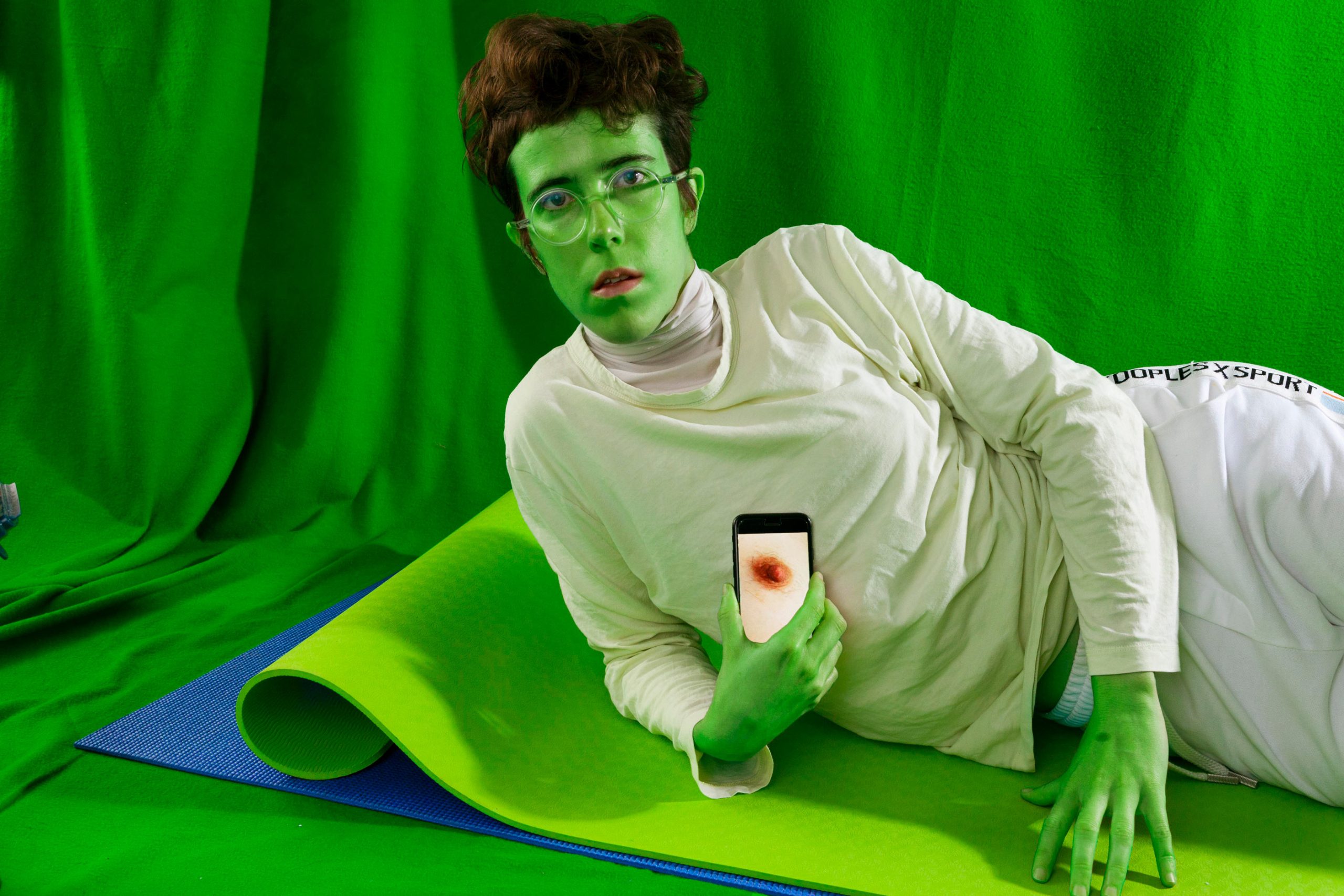
Maisy-Grey has no truck with reflective practice because it gives me too much time to plot behind the scenes, to make myself the object of my interest. But she understandably won’t tolerate me too closely either. I can do no more than sit at a safe-enough distance, keep my mouth shut, and occasionally provide small acts of kindness like quietly obliging when ordered to “pass the fucking paintbrush, perve,” or just wishing her well, with a weary smile, at a session’s end.
As she neared sixteen, Maisy-Grey unexpectedly took to making stop-start animations using found objects, and she would stay up whole nights recording her fantastical creations. One day, close to the two-year anniversary of our work, I opened an email with an attachment from her, which contained one of these shorts. It featured a moving whirlwind of tiny crumpled paper balls that unfurled, like cherry blossom in a spring gale, and scattered off a dark-oak table. Each piece revealed a carefully scrawled word. Together they read: adam I attacked you in every way I could and you didn’t give up on me thank you
In a closing shot from the biographical documentary “The Pieces I Am,” author Toni Morrison describes the weighted significance of a moment in a gallery in Vienna; a moment that seems to embody the open-hearted spirit that swells, unchecked, through the veins of her novels; a moment that perhaps encapsulates what I feel in similar moments in my own work. Peering into what seemed to be a large mirror, she was surprised, struck and then moved to find a figure quietly emerging from the other side, slowly approaching, until finally their fingertips, ever-so-softly, touched in the space between them. If there is something core to helping or healing, is it not this visceral human contact; is it not, one way or another, that we find our hearts are touched?
Winnicott, Donald W. “Mirror-Role of Mother and Family in Child Development.” Playing and Reality, Routledge, 2005, pp. 149-159.
Freud, Sigmund. “On Narcissism: An Introduction.” The Standard Edition of the Complete Psychological Works of Sigmund Freud, Volume XIV (1914-1916): On the History of the Psycho-Analytic Movement, Papers on Metapsychology and Other Works, 1914, pp. 67-102.
Grant, Michael. “The Mirror Stage: A Critical Reflection.” The Raymond Tallis Reader, edited by Michael Grant, Palgrave, 2000, pp. 253-283.
ALL OF THAT SKIN INTO MY SCREEN INTO MY HAND
In this artificial world I am holding onto my phone, a door to reality, I prop it against my body to show you what I could be. The colour green is unpredictable, awaiting a final post-production job, I could become anything. I explore the relations between my physiological body and my liquid identity, and look for a space outside of both online and offline worlds. My uncovered nipple makes it all the way to social media, but it’s no longer a nipple, not really, it’s just a screen into my hand that I am pressing where my belly button should be.
I am a photographic, digital and performance artist. My practice is concerned with the human body and its presence in a networked society. In this context I use my own body as a template to scrutinise technological ‘being.’ I focus on the development of identities torn between the inside and the outside of screens. Through performative experiments, using screens and photo-based gifs, I reflect on the ‘selves’ that make and unmake each other in online and offline spaces, and on the performance of subjectivity in these binary centres of expression — online or offline — but also increasingly blurred.
– Jeanne Tullen
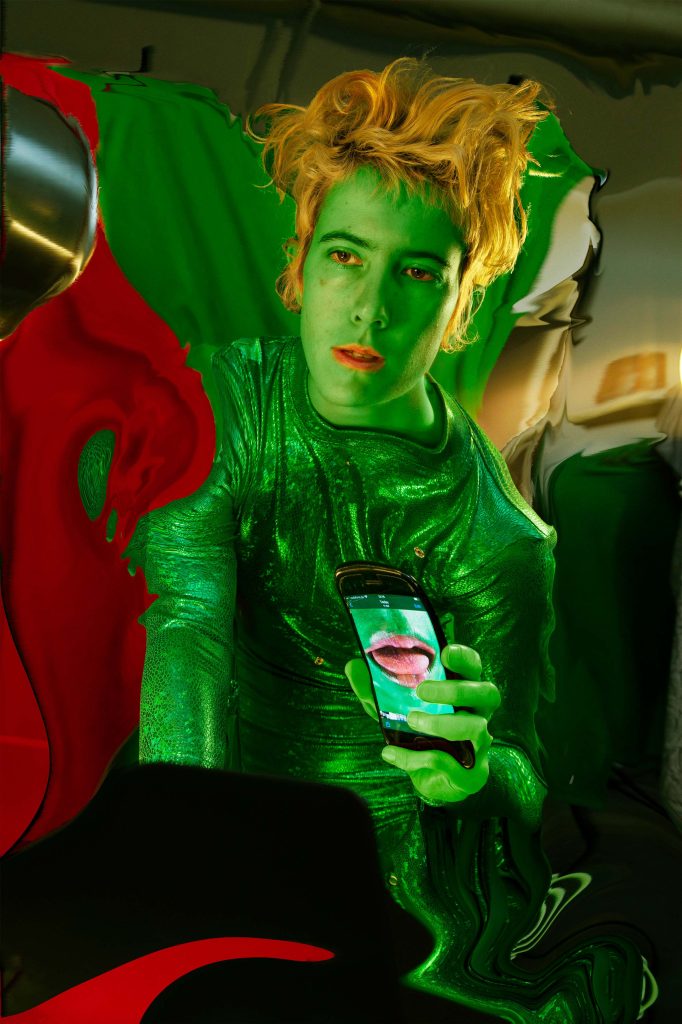
ADAM GOREN writer
Adam Goren is a psychoanalytically trained child psychotherapist and lead clinician at a CAMHS (Child and Adolescent Mental Health Service) team in London, England. He specializes in working with traumatized adopted children and their families. He is also an essayist, painter, and printmaker producing work concerned with creatively traversing borders and boundaries in search of new perspectives.
JEANNE TULLEN artist
Jeanne Tullen lives and works in Geneva. Her artistic research starts in 2010 with her Bachelor at the University of Arts in Lausanne (ECAL) through a self-portrait practice, then shifts towards performative explorations mixing photography, moving image and sound during her Masters in Fine Art at the Glasgow School of Arts (GSA). She receives the grant “Close Distance: Seeking New Cultural Formats” from Pro Helvetia in collaboration with artist web developer Rodrigo Nava Ramirez. Her solo shows include Intermedia Gallery at CCA in Glasgow, her group shows include International Festival 2021 in Glasgow, Festival Circulation(s) in Paris.
© Copyright for all texts published in Stillpoint Magazine are held by the authors thereof, and for all visual artworks by the visual artists thereof, effective from the year of publication. Stillpoint Magazine holds copyright to all additional images, branding, design and supplementary texts across stillpointmag.org as well as in additional social media profiles, digital platforms and print materials. All rights reserved.
